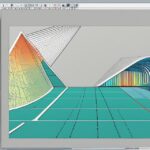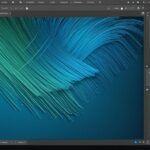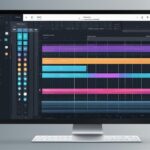Table of Contents
Welcome to our exploration of Blender, the open-source software that has revolutionized 3D design. With its comprehensive set of tools and features, Blender has become the go-to choice for artists, animators, and designers worldwide. Let’s dive into its capabilities and discover how this powerhouse software can bring your creative visions to life.
Blender offers a wide range of capabilities, allowing you to unleash your creativity and craft intricate models with ease. Whether you’re a seasoned professional or just starting out, Blender provides the professional-grade tools you need to take your 3D designs to the next level.
As an open-source software, Blender is constantly evolving, fueled by a dedicated community of artists and developers. This ensures that the software stays up to date with the latest advancements and meets the needs of artists worldwide.
Join us as we delve into the world of Blender and explore its remarkable capabilities. From its modeling tools to its animation capabilities, visual effects, game development, and architectural visualization, Blender truly has something for everyone.
Stay tuned as we uncover the power of Blender and unlock the potential of 3D design like never before. Let’s embark on this creative journey together and see what we can accomplish with this incredible open-source software.
A Brief Overview of Blender
Blender, an open-source 3D creation suite, had humble beginnings as an in-house tool for a Dutch animation studio in the early 1990s. Since then, it has evolved into a comprehensive software that empowers artists, designers, and animators to bring their creative visions to life.
With Blender’s wide array of features, users can delve into the world of 3D modeling, animation, and rendering. Whether you’re a beginner or an expert, Blender provides a rich toolkit for creating, transforming, and sculpting 3D objects. Its intuitive interface allows artists to unleash their imagination and turn their ideas into captivating visuals.
Moreover, Blender excels in the realm of animation. Its robust animation capabilities enable users to create engaging and lifelike characters and scenes through keyframe animation and rigging. From subtle movements to complex character interactions, Blender offers the flexibility and precision needed to bring animations to life.
Blender’s rendering engines further enhance the visual quality of projects, allowing users to achieve realistic and real-time renders that immerse viewers in their creations. Whether it’s a stunning still image or an interactive animation, Blender provides the tools necessary for rendering breathtaking visuals.
But Blender doesn’t stop there. It also boasts a full-fledged node-based compositor, offering post-processing capabilities and enabling artists to add stunning visual effects to their work. Additionally, Blender includes a video editor that allows for basic editing tasks, making it a versatile all-in-one solution.
To enhance its functionality even further, Blender supports Python scripting, enabling users to automate tasks and create custom tools to suit their unique needs. This flexibility and customizability make Blender a powerful ally, enabling artists to work efficiently and unleash their full creative potential.
Key Features of Blender:
- Comprehensive 3D creation suite
- Advanced modeling tools for creating, transforming, and sculpting 3D objects
- Animation capabilities for keyframe animation and rigging
- Rendering engines for realistic and real-time renders
- Node-based compositor for post-processing and visual effects
- Video editor for basic editing tasks
- Python scripting support for automation and customization
Blender’s versatility and powerful toolset have made it a go-to choice for artists, designers, and animators in the 3D industry. Whether you’re interested in creating stunning still images, captivating animations, or immersive visual effects, Blender provides the platform to turn your imagination into reality.
Blender in Action
Blender’s versatility is showcased in various fields. From 3D modeling to animation, visual effects, game development, and architectural visualization, Blender offers a wide range of capabilities that cater to the diverse needs of artists and designers.
3D Modeling
Blender provides artists with an extensive set of tools for 3D modeling. Whether you’re creating characters, vehicles, or architectural models, Blender offers both basic polygonal modeling and advanced sculpting features. Its intuitive interface and powerful functionalities make it a preferred choice for artists seeking precise and detailed 3D modeling results.
Animation and Rigging
With its wide range of options, Blender has become a popular tool for animators and game developers. The software offers sophisticated animation capabilities, including keyframe animation and rigging, allowing artists to bring their creations to life with fluid movements and realistic expressions.
Visual Effects
Blender’s compositing nodes enable seamless integration of 3D elements into live-action footage. This makes it a powerful tool for visual effects artists who wish to add stunning visual effects to their projects. The software provides a range of compositing options, allowing artists to achieve professional-grade results for films, commercials, and other visual productions.
Game Development
Blender’s Game engine enables the creation of interactive 3D experiences. Game developers can leverage Blender’s extensive features and capabilities to design and develop immersive gameplay, realistic environments, and captivating game mechanics. With its flexibility and integration with other game development software, Blender offers a comprehensive platform for game development.
Architectural Visualization
Blender’s accurate modeling and rendering capabilities make it a favored tool for architectural visualization. The software allows architects and designers to create realistic visualizations of spaces and structures, bringing their designs to life in a virtual environment. From interior renderings to external landscapes, Blender empowers professionals to present their architectural visions with stunning photorealism.
In summary, Blender’s versatility extends across multiple disciplines, highlighting its importance in 3D modeling, animation, visual effects, game development, and architectural visualization. Its comprehensive set of tools and capabilities make it a favored choice among professionals and enthusiasts alike.
The Blender Community
One of Blender’s greatest strengths lies in its passionate and dedicated community. The global network of artists and developers contributes to Blender’s continuous improvement, creates tutorials, and shares resources. This fosters a culture of collaboration and learning, where artists can connect with like-minded individuals, seek guidance, and share their work. The Blender community plays a crucial role in supporting and enhancing the software, making it even more accessible and user-friendly for artists of all levels.
Blender’s community is a vibrant hub of creativity and knowledge. Artists and developers from around the world come together to exchange ideas, share their expertise, and collaborate on projects. Whether through online forums, social media groups, or dedicated communities, Blender users have a wealth of resources and support at their fingertips.
The Blender community is a testament to the power of collaboration and open-source values. By pooling their knowledge and skills, community members enhance Blender’s capabilities and push the software to new heights.
One of the cornerstones of the Blender community is its commitment to education and learning. Artists of all skill levels can access a vast array of tutorials and educational resources created by fellow community members. From beginner-friendly introductions to advanced techniques, these resources empower users to expand their skills and unlock new possibilities within Blender.
Moreover, the Blender community embraces the ethos of open-source collaboration. Artists and developers frequently collaborate on projects, creating stunning artwork, animations, and short films together. Through this collaborative approach, Blender users not only improve their skills but also contribute to the growth and development of the software itself.
Blender’s community-driven development model ensures that the software remains relevant and responsive to the needs of its users. The community actively participates in shaping Blender’s features and functionality, making it a truly user-centric 3D creation suite.
Joining the Blender Community
For artists looking to join the Blender community, there are several avenues to explore:
- Online Forums: Websites like Blender Artists and Blender Stack Exchange host active communities where users can ask questions, seek advice, and share their work.
- Social Media Groups: Platforms like Facebook, Reddit, and Discord have dedicated Blender groups where users can engage with fellow artists and stay up-to-date with the latest news and developments.
- Blender Foundation Events: The Blender Foundation organizes events such as the Blender Conference, where artists, developers, and enthusiasts gather to share their expertise and celebrate the Blender community.
By joining the Blender community, artists can tap into a vast network of talent, resources, and inspiration. Collaboration, learning, and shared experiences are at the heart of the Blender community, empowering artists to create remarkable 3D artwork and push the boundaries of their creative expression.
Next, we’ll explore Blender’s impact and future possibilities as a powerful tool for democratizing 3D artistry and driving open-source collaboration.
Blender’s Impact and Future
Blender has revolutionized the world of 3D artistry, democratizing the field and empowering artists of all levels. With its open-source nature and powerful feature set, Blender has eliminated the barriers of expensive software and made professional-grade tools accessible to everyone, regardless of budget constraints.
But Blender’s impact goes beyond affordability. It has fostered an inclusive and collaborative environment where artists can freely create and share their work. By harnessing the power of open-source collaboration, Blender has created a global community that continuously pushes the boundaries of 3D art and animation.
Blender’s future development is driven by a strong roadmap, ensuring that it remains at the forefront of technological advancements. Constant innovation and enhancement of its features make Blender a versatile tool that adapts to the changing needs of artists worldwide.
The Blender community is at the heart of its future. With active support and involvement, the community plays a crucial role in shaping the software and driving its evolution. Through open-source collaboration, artists, developers, and enthusiasts come together to share knowledge, resources, and ideas, building upon each other’s work and propelling Blender’s growth.
As we look ahead, Blender’s future shines bright. Its potential to transform the world of 3D artistry is vast, as more and more artists embrace this open-source platform to unleash their creative visions.
The Power of Open-Source Collaboration
“Blender’s open-source nature not only democratizes 3D artistry but also fosters a culture of collaboration, where individual talents combine to create something truly remarkable.” – Artist A
Blender’s open-source collaboration enables artists to contribute to its development, enhance its capabilities, and share their expertise with the community. This culture of collaboration fuels innovation and propels the software towards new horizons.
The Future of 3D Artistry
“With its continuous development and ever-expanding feature set, Blender is spearheading the future of 3D artistry, pushing the boundaries of what’s possible and inspiring artists to unlock their creative potentials.” – Artist B
Blender’s commitment to future development ensures that it remains at the forefront of the 3D art industry. Through advancements in modeling, animation, rendering, and beyond, Blender empowers artists to bring their imaginative visions to life in breathtaking detail.
Collaborative Development Roadmap
Blender’s future is guided by a development roadmap that outlines exciting features and enhancements to come. From improved rendering engines to enhanced sculpting tools, each milestone on the roadmap brings Blender closer to its full potential.
The Evolving Blender Community
“The Blender community is like a family, united by a passion for 3D art and a shared mission to push the boundaries of creativity. Together, we shape the future of Blender.” – Artist C
The Blender community is a vibrant hub of artists, developers, and enthusiasts who actively contribute to the software’s growth. Through forums, tutorials, and collaborative projects, the community nurtures a supportive environment where artists thrive and innovations flourish.
| Benefits of Blender’s Impact | Examples |
|---|---|
| Democratizing 3D artistry | An aspiring artist without access to expensive software can now freely explore the world of 3D art and unleash their creativity. |
| Open-source collaboration | Artists from different parts of the world collaborate on a single project, pooling their talents and expertise to create stunning visuals. |
| Future development | Blender’s continuous development ensures that artists have access to the latest tools and technologies, allowing them to stay at the cutting edge of 3D artistry. |
Blender’s impact on the world of 3D artistry is undeniable. By democratizing access to powerful tools, fostering open-source collaboration, and prioritizing future development, Blender has become a driving force in the industry. As artists continue to push the boundaries of creativity, Blender will stand as a catalyst, empowering a new generation of 3D artists.
Conclusion
Blender stands as a testament to the power of open-source collaboration in the world of digital art. With its comprehensive toolset, dedicated community, and constant development, Blender has become a prominent player in the realm of 3D creation. Whether you’re a seasoned professional or an aspiring artist, Blender offers a robust platform to bring your creative visions to life.
Unlock the potential of Blender for creating stunning visuals and intricate models with its professional-grade tools. With its open-source nature, Blender empowers artists to push the boundaries of their imagination and explore new realms of 3D artistry. The software’s advanced 3D modeling, animation, and rendering capabilities enable artists to bring their ideas to life with precision and realism.
Blender’s open-source philosophy fosters a vibrant and inclusive community, where artists can connect, collaborate, and learn from each other. The constant feedback and contributions from the Blender community ensure the software continues to evolve and adapt to the changing needs of artists worldwide.
Experience the freedom and flexibility of Blender’s open-source software. Unleash your creativity, unleash your potential. Enter the world of Blender and embark on a journey of limitless possibilities for your 3D creations.
FAQ
What is Blender?
Blender is an open-source 3D computer graphics software that offers a comprehensive set of tools and features for creating stunning visuals and intricate models.
How did Blender evolve over time?
Blender was initially developed as an in-house tool for a Dutch animation studio in the early 1990s and has since evolved into a comprehensive 3D creation suite that was released as open-source software.
What are the main features of Blender?
Blender offers modeling tools, animation capabilities, rendering engines, a node-based compositor for post-processing and visual effects, a video editor, and support for Python scripting.
Which fields can Blender be used in?
Blender’s versatility makes it suitable for 3D modeling, animation, visual effects, game development, and architectural visualization.
How does the Blender community contribute to the software?
The global network of artists and developers in the Blender community contributes to continuous improvement, creates tutorials, and shares resources to make Blender more accessible and user-friendly.
How has Blender impacted the world of 3D artistry?
Blender has played a significant role in democratizing 3D artistry by making powerful tools accessible to artists of all levels, regardless of budget constraints.
What is the future of Blender?
With a strong roadmap for future development and continued support from the Blender community, Blender is constantly pushing the boundaries of 3D art and animation.













